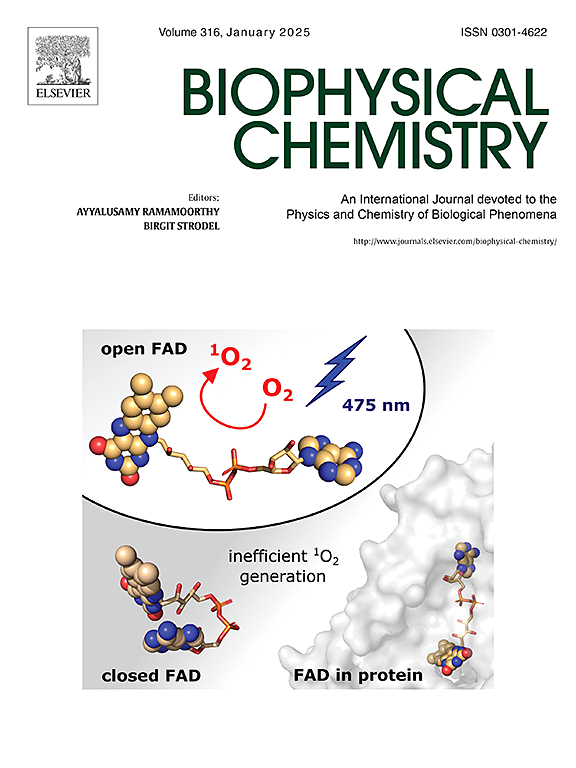On the thermal and chemical stability of DNAJB6b and its globular domains
IF 2.2
3区 生物学
Q2 BIOCHEMISTRY & MOLECULAR BIOLOGY
引用次数: 0
Abstract
The chaperone DNAJB6b (JB6) plays important roles in increasing amyloid protein solubility and inhibiting amyloid fibril formation, a causative factor for neurodegenerative diseases like Alzheimer's and Parkinson's disease. Insights into the biophysical properties of JB6, including its structure, self-assembly and stability towards denaturation, may enhance the understanding of the physicochemical basis of chaperone action. However, many of the biophysical properties of the chaperone remain elusive. Here, we investigated the structure and stability of JB6 and its domains towards thermal and chemical denaturation using Fourier transform infrared and circular dichroism spectroscopy to examine the thermodynamic properties. Both domains act as independent folding units. We find that the N-terminal domain (NTD) of JB6 is more stable than its C-terminal domain (CTD). Both domains are stabilized in the context of the full-length protein. The intact protein unfolds in a step-wise manner when subjected to a denaturing agent with the CTD unfolding at a lower denaturant concentration than the NTD. The combination of thermal and chemical denaturation followed by differential scanning fluorimetry revealed the enthalpy changes (22.6 and 26.4 kJ mol−1) and heat capacity changes (2.8 and 3.0 kJ/(mol*K)) upon denaturation of NTD alone and of NTD within the full-length protein, respectively. The understanding of JB6's biophysical properties complements the increasing amount of data on JB6's interactions with client proteins, paving the way for further investigation of the mechanism of its cellular function.

DNAJB6b及其球状结构域的热稳定性和化学稳定性
伴侣蛋白DNAJB6b (JB6)在增加淀粉样蛋白溶解度和抑制淀粉样蛋白原纤维形成方面发挥重要作用,淀粉样蛋白原纤维是阿尔茨海默病和帕金森病等神经退行性疾病的致病因素。深入了解JB6的生物物理性质,包括其结构、自组装和变性稳定性,可以增强对伴侣作用的物理化学基础的理解。然而,伴侣的许多生物物理特性仍然难以捉摸。本文采用傅里叶变换红外光谱和圆二色光谱研究了JB6的结构和稳定性,以及它的热变性和化学变性畴。这两个区域都是独立的折叠单元。我们发现JB6的n端结构域(NTD)比c端结构域(CTD)更稳定。这两个结构域在全长蛋白的环境下是稳定的。当CTD在比NTD更低的变性剂浓度下展开时,完整的蛋白质以逐步的方式展开。热变性和化学变性结合,差示扫描荧光法测定了NTD单独变性和全长蛋白内NTD变性时的焓变化(22.6和26.4 kJ mol−1)和热容变化(2.8和3.0 kJ/(mol*K))。对JB6生物物理特性的了解补充了JB6与客户蛋白相互作用的数据,为进一步研究其细胞功能机制铺平了道路。
本文章由计算机程序翻译,如有差异,请以英文原文为准。
求助全文
约1分钟内获得全文
求助全文
来源期刊

Biophysical chemistry
生物-生化与分子生物学
CiteScore
6.10
自引率
10.50%
发文量
121
审稿时长
20 days
期刊介绍:
Biophysical Chemistry publishes original work and reviews in the areas of chemistry and physics directly impacting biological phenomena. Quantitative analysis of the properties of biological macromolecules, biologically active molecules, macromolecular assemblies and cell components in terms of kinetics, thermodynamics, spatio-temporal organization, NMR and X-ray structural biology, as well as single-molecule detection represent a major focus of the journal. Theoretical and computational treatments of biomacromolecular systems, macromolecular interactions, regulatory control and systems biology are also of interest to the journal.
 求助内容:
求助内容: 应助结果提醒方式:
应助结果提醒方式:


